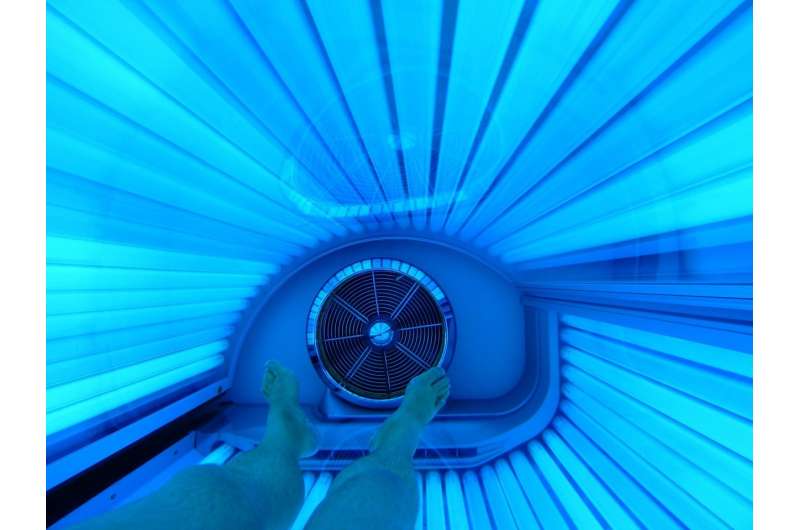This article has been reviewed according to Science X's editorial process and policies. Editors have highlighted the following attributes while ensuring the content's credibility:
fact-checked
reputable news agency
proofread
Be sun savvy, protect yourself from skin cancer

Ultraviolet rays from the sun can cause skin damage in as little as 15 minutes. Prolonged exposure and damage can lead to various forms of skin cancer, many of which, thankfully, are preventable.
The sun isn't the only skin-damaging predator. Tanning beds and smoking also can have ill effects on the body's outer layer.
What are the common forms of skin cancer?
Skin cancer can take many forms, but the three most common are:
- Basal cell carcinoma: Basal cell carcinoma is the most common type of skin cancer. It typically develops on skin that receives a lot of sun, such as the scalp, face, nose, neck and hands. It often appears as a dome-shaped growth with visible blood vessels, a shiny, pinkish patch or a sore that heals and then returns.
- Squamous cell carcinoma: Squamous cell carcinoma is the second most common type of skin cancer. It also frequently develops on skin exposed to the sun, such as the face, ears, lips, back of the hands, arms and legs. Squamous cell carcinoma often appears as a crusted or rough bump; a red, rough flat patch; a dome-shaped bump that grows and bleeds; or a sore that does not heal or heals and returns.
- Melanoma: is the deadliest form of skin cancer. It may develop on the skin or in an existing mole. Moles that change in size, color or shape, or develop symptoms, such as pain, itching or bleeding, can be a sign of melanoma. Melanoma can occur anywhere on the skin, including the hands and feet, under the fingernails or toenails, and in the mouth and genital area.
Be smart in the sun and protect your skin with these tips:
- Avoid the sun between 10 a.m. and 4 p.m. This is when the sun is most intense and produces the greatest chance of sunburn. If you must be outside during these hours, seek shade using an umbrella, tree or other shelter. Use protective clothing and sunscreen even when in the shade. Learn more with this "More Fun, Less Sun" infographic.
- Be aware of medications that increase your sensitivity to the sun. Some prescription and over-the-counter medications can make you more sensitive to sunlight. Common drugs include antihistamines such as Benadryl; nonsteroidal anti-inflammatory drugs (NSAIDs), including naproxen or ibuprofen; certain antibiotics, including Bactrim or tetracycline; antidepressants; antipsychotics and oral diabetes medications. Check with your pharmacist regarding the side effects of your medication.
- Don the right head gear. A wide-brimmed hat can protect your face, ears and neck. If you wear a baseball cap, remember to apply sunscreen to your neck and ears. Also, wear protective clothing that covers exposed areas.
- Don't use tanning beds. Tanning beds produce harmful ultraviolet A (UVA) and ultraviolet B (UVB) rays, increasing your risk for skin cancer. There also is no proven evidence that using tanning beds to obtain a "base tan" will decrease your risk of sunburn. Beyond that, using tanning beds increases the chance of developing cataracts and ocular melanoma.
- Make healthy lifestyle choices. Your behaviors and habits affect the health of your skin. Do not smoke because it damages collagen and elastin in your skin. When caring for your skin, use mild soaps and daily moisturizers while limiting hot showers which can strip essential oils from your skin. Drink plenty of water to remain hydrated, and get regular sleep to keep your skin looking refreshed.
- Perform regular skin checks. Look for any changes to moles, freckles or birthmarks. Additionally, monitor any new skin changes that have occurred. Use a mirror to evaluate hard-to-see areas, and have regular skin evaluations by your health care team or dermatologist.
- Protect children's skin. Children younger than 6 months should not use sunscreen but should be protected from the sun's rays with protective clothing and shade. Apply sunscreen regularly to children 6 months and older.
- Use sunscreen when outdoors. A higher sun protection factor, or SPF, number in sunscreen indicates increased protection. The American Academy of Dermatology recommends using at least SPF 30. Use sunscreen even on cloudy or cool days because damage from the sun's rays can still occur. Reapply every two hours. You also should reapply after swimming or when sweating. Check the sunscreen's expiration date. The shelf life typically is three years or less if it has been stored in high temperatures.
- Wear sunglasses with UVA and UVB protection.Proper, protective sunglasses help prevent damage to the sensitive skin around your eyes and block ultraviolet light from the sun that may cause cataracts.
2024 Mayo Clinic News Network. Distributed by Tribune Content Agency, LLC.
















